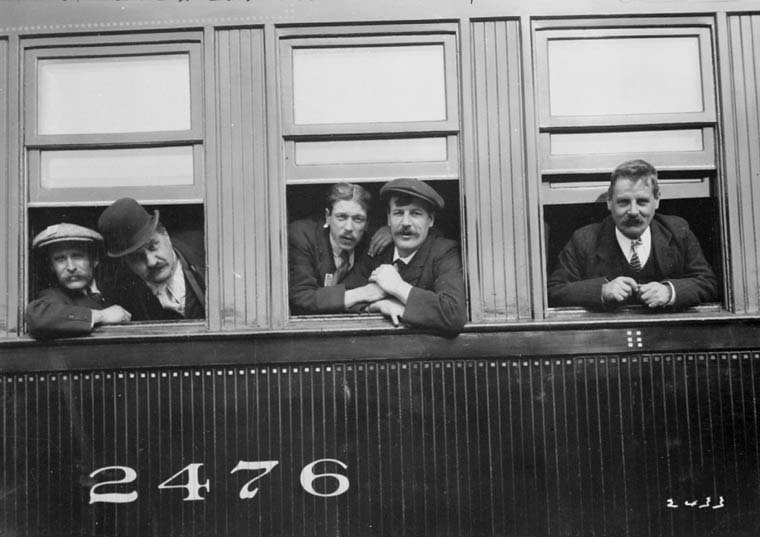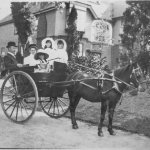your family stories
Entraining at Quebec
New immigrants entrained [boarded trains] at Quebec to travel to their destinations across Canada, after arriving in Quebec on transatlantic liners.
A few immigrants were booked for regular CNR trains. Only a handful were booked for the Grand Trunk railway going east. The returning Canadians and those going onward to the United States did not declare how they were to travel onward1.
Although the destination on many passenger ships indicated Quebec and Montreal, even those passengers destined for Montreal most often disembarked at Quebec and entrained for the continuing journey. This is true of the BICA boys. It seems First Class passengers disembarked at Montreal.
The Images
The images shown on this page are from Library and Archives Canada's Image Search. Some fantastic historic photographs of ships, trains, ports of entry, immigrants and so much more can be found by conducting a "collection search", selecting "images" and entering the search criteria.
Part 2 of Frank Yeigh's Immigration Series
The following article by Frank Yeigh is the second in a three-part series recounting the experience of newly-arrived immigrants from the UK and Europe, specifically, 3 shiploads which arrived in Quebec on the same day in May 1921.
ENTRAINING AND DISTRIBUTING THE IMMIGRANT
(Special
Correspondence of The Globe)
by Frank Yeigh
June 4, 1921 - To transfer several thousand immigrants from ships to sheds is one aspect of the present-day human in-flow; to distribute, place and assimilate them is another.
The landing of 2000 on a single day at the port of Quebec from three big liners has been described, as well as the inspection process in the Dominion Immigration Hall. Now come the succeeding steps in the process. The ground floor of the hall is crowded to its capacity for a few hours with the multitude that has successfully emerged from the ordeal of medical and civil examinations. The immense baggage-room, marked off with all the letters of the alphabet, is a scene of noisy activity as car after car is filled with trunks and boxes, and bales and dunnage bags of every known type and size, holding many a precious treasure as a link with the old life and the old home. A Galician woman gave me a bulb from her little store, and another a piece of ware, very crude in workmanship, but a gift that was rich in spiritual value. Many are nervous over the temporary disappearance of their bulky belongings, and keep close watch over the hand-carried impediments which, when added to several babies in arms and kiddies clinging to their mothers’ skirts, create a problem in locomotion.
Railway tickets have been secured over the Canadian National, Grand Trunk or the Canadian Pacific Railway, all of which have track access to the Immigration Hall; the money of many lands, paper and metal, is changed into Canadian currency by the expert money changers in their little temple booths, involving a knowledge of international finance that would paralyze a novice; telegrams are being received and sent as the little messengers add to the din with their announcements, and meetings are being arranged between friends and families.
![Trains sit beside the immigration sheds waiting for the immigrants to entrain [board] to travel to their final destinations. Trains sit beside the immigration sheds waiting for the immigrants to entrain [board] to travel to their final destinations.](https://www.recordfamilyhistory.com/images/Dominion_Government_Immigration_Sheds_with_trains.jpg) Trains waiting alongside the Dominion Immigration Sheds for entraining the new arrivals. Date and place unspecified. Credit: Canada. Dept. of Mines and Resources / Library and Archives Canada / PA-021357; Copyright: Expired.
Trains waiting alongside the Dominion Immigration Sheds for entraining the new arrivals. Date and place unspecified. Credit: Canada. Dept. of Mines and Resources / Library and Archives Canada / PA-021357; Copyright: Expired.An Army of Helpers
The helpers from churches and societies are rendering invaluable service in straightening out tangles of all kinds, carrying bundles – and babies, corralling runaway tots and answering scores of interrogations. One has mislaid his papers and tickets; a couple are being held for the production of evidence that they are married, but the thoughtless wife has left the precious document with mother overseas. Here’s a lassie who is expecting “her man,” to conclude an engagement entered into in her European home – and he has not yet turned up. Here, too, is a man who finds that the girl in question has changed her mind – not the only case on record. So the stories go – problems, romances, reunions, troubles, things-gone-wrong; other things gone and going right, and all’s well in the world. Then it is that the chaplain, or the deaconess, or the Sister, or the “Y” Secretary, or the Red Cross nurse, flitting through the crowd like a white flower, renders first aid that is much more than medical; it is mental and spiritual in its quality, and lightens the load the newcomer may be carrying.
The big ships and the ocean voyage and the disembarkation are already things of the past. Where next? And when? Are the dominating questions. Rumors pass through the crowds like wireless messages that have no relation to the actual facts. “Where’s my train?” “When and where do we leave from?” “Where do we change?” “When will we reach Winnipeg – or Edmonton – or Vancouver?”
This is the job that faces the railwaymen. Ranged alongside the Hall is track after track filled with train after train of innumerable cars – tourist, colonist and day coaches, all swept and cleaned and aired ready for the inflow. Government guards man the crowded exit and railway officials are at their posts, acting with military precision in sorting out the stream of passengers.
The air is tense with excitement as the first orders are given to entrain. Folks of many races and lands centre at the big door, and yet that is scarcely large enough to accommodate them. Heads of families have their work cut out to keep their flocks intact, while friendly groups, formed on shipboard, endeavor to continue as such on the land journey. So the surge trainward sets in, of assorted ages and sizes and shades of color. No wonder the immigration tables show over fifty nationalities and races represented in this human inflow Canadaward.
Baby Immigration.
Boys and babies are among them. Have you ever realized the importance of both the baby and the boy immigrants? Seventy-three thousand boys and girls have come to Canada in the last twenty years, mostly from institutional homes in the British Isles. Many came in 1920, and a party of 400 are on the ocean as I write. Mr. Bogue Smart, the Chief Inspector of British immigrant children and receiving and distributing homes, reports that of the 73,000 boys and girls thus brought to and settled in Canada, the great majority, after serving their apprenticeships with farmers, have followed agriculture as their vocation. When it is remembered that these children come to Canada between the impressionable ages of seven and fourteen, they readily become imbued with Canadian sentiment and customs. The estimate that over 90%, of them make good in their adopted country confirms the value of this type of immigration.
And what’s a baby immigrant worth? In the eyes of its fond parents, the market value would be about 100 million – plus, without any discounts for exchange or adverse balance of trade. It is estimated that an adult immigrant is worth $1000, as a producer and consumer, but surely the baby should rank higher in its ultimate value through being caught young and thus growing up with the country.
![While waiting to entrain [board trains] to their final destinations, new arrivals with babies and children could spend time in the Red Cross Room at the Immigration Hall in Quebec. While waiting to entrain [board trains] to their final destinations, new arrivals with babies and children could spend time in the Red Cross Room at the Immigration Hall in Quebec.](https://www.recordfamilyhistory.com/images/Red_Cross_Room_Immigration_Building_Quebec.jpg) The Red Cross Room at the Immigration Hall in Quebec, set up for babies and children.
Credit: National Film Board of Canada. Photothèque/Library and Archives Canada/PA-048699; Copyright: Expired.
The Red Cross Room at the Immigration Hall in Quebec, set up for babies and children.
Credit: National Film Board of Canada. Photothèque/Library and Archives Canada/PA-048699; Copyright: Expired.Step into the Red Cross nursery before we leave Immigration Hall, set up for the first time this season. It is filled to capacity with embryo men and women, all cooing in gooing and gurgling and chuckling in baby Esperanto, while drinking enormous quantities of milk and eating all the cookies in sight – all except one little Britisher who raises a Sinn Fein riot over a fancied grievance, and in his red-faced anger side swipes a bottle of milk over his kindergarten table and chair, over his own little person and far afield to other babies who thus had a deluge of white. He is greatly pleased with the excitement he causes. But every other occupant of Babyland regards this display of temper as unwarranted, ungrateful and unmannerly, and plainly said so.
In course of time, and relatively brief time, considering the size of the job, trains are filled and started on the next leg of the journey, a long journey for some – for the Roumanian bound for Edmonton, for the family bound for Moose Factory on Hudson Bay, involving a five-day canoe trip over the Missinabie after leaving the train on the Transcontinental. Here’s a young English couple, she an English bride, he a Canadian soldier, only now returning with wife and brand-new kiddie, heading for Vancouver. By way of change, an Italian is steering towards Sydney, and cotteries of Polish Jews for the cities. Domestic helpers are already engaged, and are fulfilling their part of the contract by coming out. So there is infinite variety and objectives as in personalities, as one discovers on the train journey, visiting coach after coach.
 This image of Scottish men after entraining ready to travel to their new homes was taken in 1911.
Credit: William James Topley / Library and Archives Canada / PA-010391;
Copyright: Expired.
This image of Scottish men after entraining ready to travel to their new homes was taken in 1911.
Credit: William James Topley / Library and Archives Canada / PA-010391;
Copyright: Expired.By a wise arrangement of the powers that be, families have been placed in special cars, unattended women in others, leaving the unfortunate single men to flock by themselves. By an equally wise arrangement of the Department of Immigration and Colonization, and through the Canadian Council of Women for the Immigration of Household Workers, bright, alert and trained young women act as “conductorettes” on the trains, rendering invaluable services to the women folks. “Do you think we can brew some tea?” And English matron asks me, and when a few minutes later that “conductorette” started the charcoal stove going, and afternoon tea was made possible at the correct afternoon hour, all the remaining clouds of anxiety and tiredness rolled away and her last trouble was packed away in the feminine kit bag.
The Signs of Plenty
Dear old Quebec looked its most picturesque as, in the cool of the evening, the long train circled the base of Cape Diamond and carried its human load through and across the fertile fields of Canada’s largest Province and past the whitewashed homes of the habitant. Everything betokened peace, plenty and prosperity – a happy augury, one thought, for the army of newcomers gazing upon the fair scene with eager eyes, gazing upon their home-to-be.
After the few hours’ run Montreal is neared – Canada’s largest city, her commercial metropolis. Those bound for the West will only pause for a brief half hour in the big station, ere heading westerward for the additional journey of many hundred leagues for “Westward Ho” is still the cry for those who are seeking great adventures. Succeeding trains are heading for Toronto, where there will be further distributions for Western Ontario points, and here it may be well to remove the impression that a large proportion of the great immigrant inflow goes West – that is, west of the Great Lakes. Of the arrivals at the Atlantic Ocean ports during 1920, nearly half stopped in Ontario.
We have thus accompanied the immigrant up the St. Lawrence to the port of Quebec, seen him disembark and pass the port examinations, witnessed the inspectors O K his papers that ensure entrance into the family of the Dominion; we’ve gone with him through the experiences in the Immigration Hall and helped him entrain, and now he is on his way to his new home and new life. One wonders where it will be; one wishes him the fullest degree of success in this goodly land of Canada.
References: Immigrating to Canada 1921 - Frank Yeigh Articles
Read an overview of traveling by Ship across the Atlantic
Shipping News in the Montreal Gazette February 1907
Stories about arriving in Canada on the Empress of England and others


